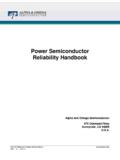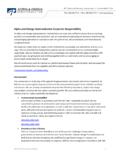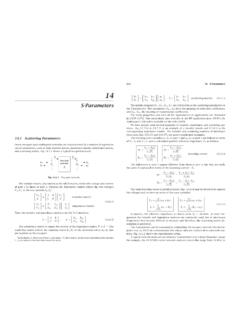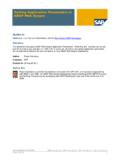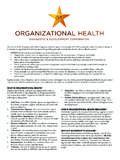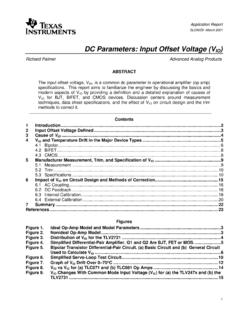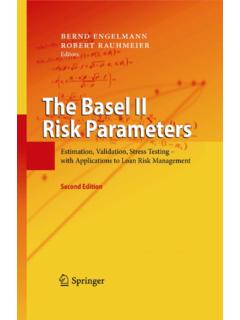Transcription of High Voltage Power MOSFET switching parameters: Testing ...
1 High Voltage Power MOSFET switching parameters : Testing Methods for Guaranteeing datasheet limits Anup Bhalla, Fei Wang Introduction Power MOSFET datasheets will usually show typical and min-max values for Rg, Ciss, Crss, Coss, and also show values for gate charge broken down into Qgs, Qgd, Qg. It is also customary to show values for switching times during resistive switching , td(on), trise, td(off), tfall. (For a glossary of terms, see appendix I) It is well known that the device parameters Qgs, Qgd, Qg have a one-to-one correlation with the parameters Ciss and Crss [1]. In other words, once we measure device capacitances, we can guarantee the values of the gate charge parameters . The gate charge captures the charge needed to move the gate from 0V to the desired Voltage , and integrates the non-linear capacitance over that Voltage range. The measurement of switching times are controlled by the following factors: [1,2] td(on) Rg, Ciss, Vth, gm relating to the device, and gate driver characteristics.
2 Trise Rg, Crss, Ciss, gm, Vth, Ls - relating to the device, and gate driver characteristics, RL and circuit layout stray inductances td(off) - Rg, Ciss, Vth, gm relating to the device, and gate driver characteristics. tfall Rg, Crss, Ciss, gm, Vth, Ls - relating to the device, and gate driver characteristics, RL and circuit layout stray inductances Clearly, once the Rg, Ciss, Crss for the device is measured, along with Vth and gm in static Testing , the switching parameters are automatically guaranteed for that device in a fixed switching circuit. The stray inductance of the packaged unit is not measured, but since it depends only on wire count and placement, the tight control of this parameter ensures very little variability in Ls. Therefore, a measurement of Rg, Ciss, Crss and Coss is enough to guarantee the gate charge and switching time parameters for the device. Including the Coss, this covers all device parameters that affect MOSFET switching losses.
3 Physics of dynamic parameters A. Gate resistance The distributed gate resistance of a Power MOSFET is pictorially represented in figure 1. Rg is controlled by only a few factors for a device with a given layout Poly sheet resistance and width and thickness control Contact resistance between Gate metal and Poly Gate metal sheet resistance and width control Package gate wire resistance is usually a very small contributor to Rg, varies very little, and is ignored. On each wafer, a long Poly Resistor is used to monitor the resistance of a line of Poly. A four terminal Kelvin measurement is performed on the structure located in the standard process control monitor (PCM) tested on each production wafer. Rpoly behavior for typical AOS product is shown in figure 2. The contact resistance between gate metal and Poly is monitored using a 4-terminal Kelvin structure. Rgks is monitored in the same fashion using the PCM. Rgks behavior for typical AOS product is shown in figure 3.
4 2 May 20, 2009 AOS Copyrighted The metal sheet resistance for a 1000um long 10um wide metal bus is monitored using a structure located in the standard process control monitor (PCM) tested on each production wafer. Rmet behavior for typical AOS product is shown in figure 4. It is clear that control of these parameters is excellent in AOS products. Figure 1: Model representation of the distributed gate resistance of a Power MOSFET . The metal gate bus around the device is shown in blue. The gate pad is located at the corner in this case. Gate Polysilicon are shown in pink and they contact the metal bus at the edges of the die. The distributed capacitance between the gate Polysilicon and the silicon (Source/Drain) regions is represented by the capacitors distributed along the Gate. Rpoly - AOTF10N6001234567891012345 Lot NumberRpolyMedian10% percentile90% percentile Figure 2: Poly resistance monitored for HV Planar MOSFET . Note the median, 10th and 90th percentile lines are very close to each other, indicating tight process control.
5 This plot covers a period from Jan - June 2008. 3 May 20, 2009 AOS Copyrighted Rgks - AOTF10N600204060801001201401601802001234 5 Lot NumberRgksMedian10% percentile90% percentile Figure 3: Gate contact resistance monitored for HV Planar MOSFET . Note the median, 10th and 90th percentile lines are very close to each other, indicating tight process control. This plot covers a period from Jan - June 2008. Rmet - + NumberRmetMedian10% percentile90% percentile Figure 4: Resistance of a 1000um long 10um wide metal line monitored for HV Planar MOSFE. Note the median, 10th and 90th percentile lines are very close to each other, indicating tight process control over metal resistivity, line width and film thickness. This plot covers a period from Jan - June 2008. Now consider the distributed nature of the MOSFET Rg as shown in figure 1. If any one contact is not completely open, or a small area has a high Rpoly, it will have little or no effect on Rg or the device, because the gate signal will re-route itself through the many parallel paths in close proximity.
6 All AOS layouts are done with this in mind. If the entire device has a problem with Rpoly, Rmet or Rgks, it can occur only if the wafer, or a section of the wafer has a problem with that parameter. By locating PCMs at the center and wafer edges, much of this can be monitored. Measurement of Rg at the wafer level has traditionally been thought to be quite difficult for Power mosfets designed for low Rg. This is true, so Testing is often done 100% at the Final test station using one of the handler sites by AOS. Moreover, AOS has developed proprietary techniques to accurately test Rg of our devices at the wafer level, and simultaneously test the biased Ciss, Crss, Coss and static parameters . This technique is applied to a 200 site sample on the wafer to guarantee 100% Rg, Ciss, Crss and Coss parameters on the datasheet. Rg is also 100% tested at Final test to ensure goot gate wire contact to the gate pad. By extension, the gate charge and switching time parameters are 100% guaranteed.
7 4 May 20, 2009 AOS Copyrighted Figure 5 shows typical distribution of Rg on a wafer. Figure 6 shows a typical wafer map. Most of the variation in Rg, though small, is actually known to come for limitations of the tester. Figure 7 compares the test results between wafer probing and packaged device Testing for the same device. Figure 8 shows the lot to lot variation over time in the form of a control chart a typical high volume AOS products. Most of the guardband in Rg specification is applied to handle test capability issues and not due to actual wafer process capability. (ohms)Percentage900kHz, Figure 5: Rg distribution for 200 sites on a wafer taken on a HV Planar FET. RG (Ohm)Sum XY4 6 Figure 6: Typical Wafer Map of Rg distribution. Probed column and row numbers shown in bold italics. Actual values shown on the wafermap. The values are very tightly distributed. 5 May 20, 2009 AOS Copyrighted (ohms)PercentageWafer Level RgFinal Test Rg Figure 7: Comparison of wafer level and package level Rg measurements.
8 Excellent agreement is obtained. Rg - + + + + + + + + + + +0112345 Lot NumberRgMedian10% percentile90% percentile Figure 8: Lot by Lot trench chart of RG for a HV Planar MOSFET AOTF10N60. Note the tight 10th to 90th percentile lines, grouped right near the median line. Most of the variation is actually from test accuracy. Device Capacitances The datasheet capacitances are defined in terms of the structural capacitances as follows: Ciss = Cgs + Cgd Crss= Cgd Coss = Cgd + Cds The Ciss for a Planar MOSFET is determined by layout parameters like Poly width, Cell pitch gate oxide thickness and uniformity Source-Body-Epi doping profiles Gate Poly doping is usually not a factor, since it is degenerately doped 6 May 20, 2009 AOS Copyrighted N+ SubstrateDrainGateCgsCgdCdsN+ SubstrateDrainGateCgsCgdCdsN+ SubstrateDrainGateCgsCgdCdsEpi Figure 9: Device capacitances of the basic HV Planar Power MOSFET . This parameter is dominated by the capacitance between the gate Poly and the source-channel regions, which is not bias sensitive and very repeatable.
9 The Crss for a HV Planar MOSFET is determined by layout parameters like Poly width, cell pitch gate oxide thickness and uniformity Body lateral diffusion, which determines the width of the JFET region Body-Epi and JFET region doping profiles Gate Poly doping is usually not a factor, since it is degenerately doped This parameter is dominated by the width of the JFET region, JFET profile and epi doping profile. The Coss for a HV Planar MOSFET is determined by All parameters that affect Crss, since it is part of Coss and Body diode p-n junction area and doping profile Figure 10 shows the typical distribution for these parameters on a wafer. Figure 11 shows the wafer map for the same distribution. 7 May 20, 2009 AOS Copyrighted AOTF10N60 Wafer Level (pF)PercentageCissCrssCoss Figure 10: Distribution of Ciss, Crss, Coss for the 200 sites tested on a wafer (AOTF10N60). Excellent process control leads to a very tight parameter distribution.
10 CISS (pF)Sum oXY0123456789101131320 13201330 131041320 1320 1330 1330 1330 1330 133051320 1320 1320 1330 1330 1330 1320 133061320 1320 1320 1330 1330 1330 1320 1330 132071310 1320 1320 1320 1320 1320 1330 1320 1320 132081310 1320 1320 1320 1320 1320 1320 1320 1320 1320 132091310 1320 1320 1320 1320 1320 1320 1310 1320 1320 1320101310 1320 1310 1320 1320 1320 1320 1320 1320 1320 1310111310 1310 1320 1320 1320 1320 1320 1310 1310 1320 131012 1300 1310 1320 1310 1320 1320 1320 1320 1310 1310 1320 131013 1300 1310 1320 1310 1320 1320 1320 1320 1310 1310 1320 1310141310 1320 1310 1310 1320 1320 1320 1310 1310 1320 1310151310 1320 1310 1520 1320 1320 1320 1310 1310 1310 1320161310 1320 1310 1310 1320 1320 1320 1310 1310 1320 1310171310 1320 1320 1310 1320 1320 1320 1310 1320 1320181310 1320 1320 1310 1310 1320 1320 1320 1320 1320191320 1320 1320 1320

